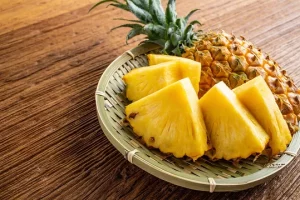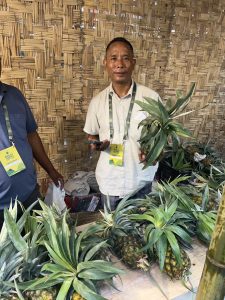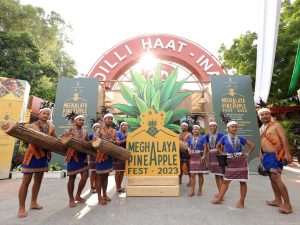– C K Nayak
Travellers on their way into and out of Meghalaya make a pit stop at Nongpoh, Ri Bhoi, a popular midpoint on the journey not for being touristy but to buy the famous pineapples of Meghalaya, considered to be the best in taste and finest in quality earning the sobriquet ‘fine apple’. The national highway linking Shillong with Guwahati is dotted with small roadside temporary shops mostly run by tribal women selling pineapples among other local fruits and vegetables.
Showcasing this luscious fruit in the capital of the country, earlier this month in Dilli Haat, an open-air market with a food plaza and crafts bazar at the heart of national capital was aplenty with visitors, many of whom were travellers from abroad, who thronged to witness the fresh pineapples from the Meghalaya Pineapple Festival organised by the state Government. According to the organisers about ten thousand full pieces of pineapples were sold during the festival with earnings of approximately seven lakh rupees. There were huge sales from accompanying other indigenous products of the state displayed in different stalls. Resident of Garo Hills now based in Delhi, WK Sangma, who tasted the pineapple sold after cutting said that it rekindled his memory of his home back in Meghalaya.
While all arrangements were made for successful start to finish, organising and detailing of such public events takes meticulous handling, if slipped, often causes a little chaos in the backdrop. This event was no different. The farmers, mostly from co-operatives, without equipment, had to struggle to detach the stems and put the fruits in cotton bags for the buyers. “The rush of buyers was so much that it was difficult to sell and collect money at the same time,” said Phrim Nongsiej, a farmer from the Khasi Hills.

The hot and humid weather in Delhi did not aid the longevity of the highly perishable fruit either. In his speech CM lamented, “Meghalaya produces one and half lakh tones of pineapple per annum but about 40,000kg goes in waste in the absence of marketing, storage and processing facilities.”
Not anticipating large sales, the stock of pineapples was over halfway through the second day of the fest and there were murmurs of closing the shops and somehow stretching it to the third and last day. However, as the demand was ever so high, disappointing many buyers on the non availability of the fruit, the officers in charge of the first ever festival fanatically rang high rung officers seeking help, after which officials managed to replenish fresh stock from Meghalaya through flight from Guwahati. A momentary sigh of relief but the tribulations did not end here as bulk orders started pouring in pushing the organisers run helter-skelter to Meghalaya House to bring in pineapples, while other consignments were dispatched to Mumbai and Bangalore.
Another area that raised eyebrows were the discrepancy in prices, as officially the price was at 10-15 rupees in the market but the actual cost was higher both in the market and sales at the Haat. Some bought four pieces for 70 rupees each. This can be explained by the high demand, low availability of the product as well as the weather conditions that exacerbated its perishable nature.

Surpassing this crisis, the festival garnered positive feedback too. While guests and visitors at the haat demanded for opening a permanent outlet in Dilli Haat for pineapples, taking to X(formerly Twitter) the Prime Minister, Narendra Modi also expressed his delight on the recognition of the fruit.
The three-day festival was inaugurated by the Union Minister for Rural Development, Giriraj Singh on August 18 which was graced by Chief Minister, Conrad Sangma. Minister for Agriculture & Farmers Welfare, Dr Ampareen Lyngdoh, Minister for Tourism, Paul Lyngdoh and Chief Secretary, D P Wahlang were present among some dignitaries from embassies. The idea of the first ever pineapple festival was not only to showcase the ‘excellent fruit’ but also make a case for attracting tourists to the scenic state. There were also traditional cultural shows all through the festival.
Meghalaya is the fifth largest pineapple producing state in the country after West Bengal, Assam, Karnataka and Tripura. Historically, this tropical fruit originated in South America and was introduced by none other than Christopher Columbus in Europe. Much later the Portuguese started its cultivation in 1548 AD in India during colonial rule. At present, the state is racing in both the aspects of cultivation and marketing of this fruit extending its reach beyond the country. The hill state produces on average 1.50 lakh tonnes of pineapples during the season in the second half of the year. The variety of pineapple found in Meghalaya is the ‘Kew’ variety which is a late-maturing one and is the leading commercial variety in India and abroad. The pineapples from the state are mostly organic with almost zero pesticide usage and heavy metal residue compared to pineapples from other states. Also, in terms of taste, these are less sour and significantly sweeter. The pineapples have a brix value of 16-18, which indicates the sweetness of the fruit. Nutrition wise, the fruit provides plenty of nutrients, low in calories and high in vitamins and minerals. It also has many curative values like healing tissues, fighting inflammation and relieving arthritis pain. Every part of this versatile fruit is useful during the canning process. The flesh is canned in slices or in crushed form and the juice is also canned. The shells and other parts are shredded, pressed, and dried to make pineapple bran to feed livestock. Other by-products of the canning process are sugar, alcohol, and vinegar.
commercial variety in India and abroad. The pineapples from the state are mostly organic with almost zero pesticide usage and heavy metal residue compared to pineapples from other states. Also, in terms of taste, these are less sour and significantly sweeter. The pineapples have a brix value of 16-18, which indicates the sweetness of the fruit. Nutrition wise, the fruit provides plenty of nutrients, low in calories and high in vitamins and minerals. It also has many curative values like healing tissues, fighting inflammation and relieving arthritis pain. Every part of this versatile fruit is useful during the canning process. The flesh is canned in slices or in crushed form and the juice is also canned. The shells and other parts are shredded, pressed, and dried to make pineapple bran to feed livestock. Other by-products of the canning process are sugar, alcohol, and vinegar.
These are the reasons why the fruit has proven victorious not only in Delhi but also in faraway United Arab Emirates (UAE). The sweetest pineapples from the state are now being sold at the Al-Wahda Mall at Abu Dhabi, UAE. Apart from Assam, pineapples are also shipped to Karnataka in huge numbers (40 tonnes in the previous year) for processing and then exported to European and North American markets. The climate of Meghalaya especially in the lower and warmer belts is conducive for growing different kinds of fruits and most of them are organic. In an effort to assist local farmers in cost cutting as well as timesaving mechanism, a mobile processor unit was established at Umdihar village, Ri Bhoi District near Nongpoh the district headquarter, which brought down wastage to about a third of its production in the state.



